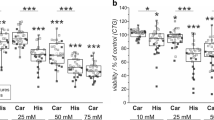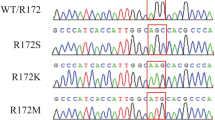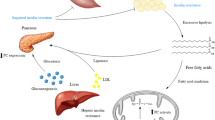Abstract
Carnosine (β-alanyl-l-histidine) is a naturally occurring dipeptide that shows antineoplastic effects in cell culture as well as in animal experiments. Since its mode of action and the targets at the molecular level have not yet been elucidated, we performed qRT-PCR experiments with RNA isolated from glioblastoma cell lines treated with carnosine, β-alanine, l-alanine, l-histidine and the dipeptide l-alanine-l-histidine. The experiments identified a strong induction of expression of the gene encoding pyruvate dehydrogenase 4 (PDK4) under the influence of carnosine and l-histidine, but not by the other substances employed. In addition, inhibition of cell viability was only detected in cells treated with carnosine and l-histidine, with the latter showing a significantly stronger effect than carnosine. Since the tumor cells expressed the tissue form of carnosinase (CN2) but almost no serum carnosinase (CN1), we conclude that cleavage by CN2 is a prerequisite for the antineoplastic effect of carnosine. In addition, enhanced expression of PDK4 under the influence of carnosine/l-histidine opens a new perspective for the interpretation of the ergogenic potential of dietary β-alanine supplementation and adds a new contribution to a growing body of evidence that single amino acids can regulate key metabolic pathways important in health and disease.








Similar content being viewed by others
References
Boldyrev AA, Aldini G, Derave W (2013) Physiology and pathophysiology of carnosine. Physiol Rev 93:1803–1845
Bunik VI, Tylicki A, Lukashev NV (2013) Thiamin diphosphate-dependent enzymes: from enzymology to metabolic regulation, drug design and disease models. FEBS J. doi:10.1111/febs.12512
Cartwright SP, Bill RM, Hipkiss AR (2012) L-carnosine affects the growth of Saccharomyces cerevisiae in a metabolism-dependent manner. PLoS ONE 7:e45006
Daniel H, Kottra G (2004) The proton oligopeptide cotransporter family SLC15 in physiology and pharmacology. Pflug Arch Eur J Phys 447:610–618
Gaunitz F, Heise K (2003) HTS compatible assay for antioxidative agents using primary cultured hepatocytes. Assay Drug Dev Technol 1:469–477
Gaunitz F, Hipkiss AR (2012) Carnosine and cancer: a perspective. Amino Acids 43:135–142
Gautam P, Nair SC, Gupta MK, Sharma R, Polisetty RV, Uppin MS, Sundaram C, Puligopu AK, Ankathi P, Purohit AK, Chandak GR, Harsha HC, Sirdeshmukh R (2012) Proteins with altered levels in plasma from glioblastoma patients as revealed by iTRAQ-based quantitative proteomic analysis. PLoS ONE 7:e46153
Grassian AR, Metallo CM, Coloff JL, Stephanopoulos G, Brugge JS (2011) Erk regulation of pyruvate dehydrogenase flux through PDK4 modulates cell proliferation. Genes Dev 25:1716–1733
Gulewitsch W, Amiradzibi S (1900) Ueber das Carnosin, eine neue organische Base des Fleischextraktes. Ber Deut Chem Ges 33:1902–1903
Hipkiss AR, Gaunitz F (2013) Inhibition of tumour cell growth by carnosine: some possible mechanisms. Amino Acids. doi:10.1007/s00726-013-1627-5
Holliday R, McFarland GA (1996) Inhibition of the growth of transformed and neoplastic cells by the dipeptide carnosine. Br J Cancer 73:966–971
Horii Y, Shen J, Fujisaki Y, Yoshida K, Nagai K (2012) Effects of l-carnosine on splenic sympathetic nerve activity and tumor proliferation. Neurosci Lett 510:1–5
Icard P, Poulain L, Lincet H (2012) Understanding the central role of citrate in the metabolism of cancer cells. Biochim Biophys Acta 1825:111–116
Iovine B, Iannella ML, Nocella F, Pricolo MR, Baldi MR, Bevilacqua MA (2011) Carnosine inhibits KRas-mediated HCT-116 proliferation by affecting ATP and ROS production. Cancer Lett 315:122–128
Lenney JF, Peppers SC, Kucera-Orallo CM, George RP (1985) Characterization of human tissue carnosinase. Biochem J 228:653–660
Nagai K, Suda T (1986) Antineoplastic effects of carnosine and beta-alanine–physiological considerations of its antineoplastic effects. J Phys Soc Jpn 48:741–747
Pilegaard H, Neufer PD (2004) Transcriptional regulation of pyruvate dehydrogenase kinase 4 in skeletal muscle during and after exercise. Proc Nutr Soc 63:221–226
Renner C, Seyffarth A, de Arriba S, Meixensberger J, Gebhardt R, Gaunitz F (2008) Carnosine inhibits growth of cells isolated from human glioblastoma multiforme. Int J Pept Protein Res 14:127–135
Renner C, Asperger A, Seyffarth A, Meixensberger J, Gebhardt R, Gaunitz F (2010a) Carnosine inhibits ATP production in cells from malignant glioma. Neurol Res 32:101–105
Renner C, Zemitzsch N, Fuchs B, Geiger KD, Hermes M, Hengstler J, Gebhardt R, Meixensberger J, Gaunitz F (2010b) Carnosine retards tumor growth in vivo in an NIH3T3-HER2/neu mouse model. Mol Cancer 9:2
Roche TE, Hiromasa Y (2007) Pyruvate dehydrogenase kinase regulatory mechanisms and inhibition in treating diabetes, heart ischemia, and cancer. Cell Mol Life Sci 64:830–849
Sakata K, Yamashita T, Maeda M, Moriyama Y, Shimada S, Tohyama M (2001) Cloning of a lymphatic peptide/histidine transporter. Biochem J 356:53–60
Smith DE, Clémençon B, Hediger MA (2013) Proton-coupled oligopeptide transporter family SLC15: physiological, pharmacological and pathological implications. Mol Aspects Med 34:323–336
Son DO, Satsu H, Shimizu M (2005) Histidine inhibits oxidative stress- and TNF-alpha-induced interleukin-8 secretion in intestinal epithelial cells. FEBS Lett 579:4671–4677
Son DO, Satsu H, Kiso Y, Totsuka M, Shimizu M (2008) Inhibitory effect of carnosine on interleukin-8 production in intestinal epithelial cells through translational regulation. Cytokine 42:265–276
Sutendra G, Michelakis ED (2013) Pyruvate dehydrogenase kinase as a novel therapeutic target in oncology. Front Oncol 3:38
Teufel M, Saudek V, Ledig JP, Bernhardt A, Boularand S, Carreau A, Cairns NJ, Carter C, Cowley DJ, Duverger D, Ganzhorn AJ, Guenet C, Heintzelmann B, Laucher V, Sauvage C, Smirnova T (2003) Sequence identification and characterization of human carnosinase and a closely related non-specific dipeptidase. J Biol Chem 278:6521–6531
Vistoli G, Pedretti A, Cattaneo M, Aldini G, Testa B (2006) Homology modeling of human serum carnosinase, a potential medicinal target, and MD simulations of its allosteric activation by citrate. J Med Chem 49:3269–3277
Wu G (2013) Functional amino acids in nutrition and health. Amino Acids 45:407–411
Yamashita T, Shimada S, Guo W, Sato K, Kohmura E, Hayakawa T, Takagi T, Tohyama M (1997) Cloning and functional expression of a brain peptide/histidine transporter. J Biol Chem 272:10205–10211
Acknowledgments
We like to thank Dr. Hans-Heinrich Foerster from the Genolytic GmbH (Leipzig, Germany) for genotyping and confirmation of cell identity. We also thank Berthold Technologies (Bad Wildbad, Germany) for the kind disposal of a Mithras LB 940 Multimode Microplate Reader and last not least Mr. Rainer Baran-Schmidt for technical assistance.
Conflict of interest
The authors declare no competing financial interests.
Author information
Authors and Affiliations
Corresponding author
Additional information
U. Letzien and H. Oppermann contributed equally to the work.
Electronic supplementary material
Below is the link to the electronic supplementary material.
726_2014_1664_MOESM1_ESM.tif
Fig. 1_to_supplement_2 Viability of HEK293 cells in the presence of carnosine. Human embryonic kidney cells (HEK293) were cultivated in different concentrations of carnosine, and cell viability was determined after 24, 48 and 72 h. Viability was determined by CellTiterGlo (Fig. 1a) and CellTiterBlue assay (Fig. 1b). Experiments were performed in sextuplicate. *: p < 5 × 10−2; **: p < 5*10−3; ***: p < 5x10−4. (TIFF 4692 kb)
726_2014_1664_MOESM2_ESM.tif
PDK4: Cells from the non-cancerous human embryonic kidney cell line HEK293 were incubated in the absence and presence of carnosine and l-histidine for 24 h, and the relative expression of mRNA encoding PDK4 was determined and compared to untreated control. Measurement was performed as quintuplicate. p < 5x10−4; **: p < 5x10−3; *: p < 5x10−2. (TIFF 3839 kb)
Rights and permissions
About this article
Cite this article
Letzien, U., Oppermann, H., Meixensberger, J. et al. The antineoplastic effect of carnosine is accompanied by induction of PDK4 and can be mimicked by l-histidine. Amino Acids 46, 1009–1019 (2014). https://doi.org/10.1007/s00726-014-1664-8
Received:
Accepted:
Published:
Issue Date:
DOI: https://doi.org/10.1007/s00726-014-1664-8




